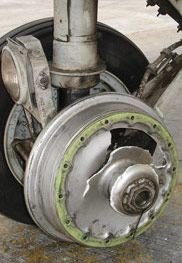
 |
In the last 20 years, a number of severe injuries — including several incidents of dismemberment and three fatalities — occurred during the inflation of nose wheel/tire assemblies on airplanes. Over-pressurization can cause an explosion that fractures the wheel during tire inflation, ejecting fragments at a high velocity. Typically, an unregulated nitrogen supply is responsible for the explosion. Virtually every accident involving nose wheel/tire inflation can be prevented by consistently following simple precautions. |
|
|
WHEEL DAMAGE DUE TO OVERINFLATION Figure 1 A maintenance worker was fatally injured in 2006 during inflation of a 737 nose wheel/tire assembly with an unregulated nitrogen pressure source that allowed the wheel to be exposed to the full pressure inside the nitrogen bottle. In this case, the nitrogen bottle was reported to be at 3,000 psi while the service pressure for the wheel was 166 psi. |
by Chris Dubuque, Inflating a commercial airplane's tires is a routine task that occurs without problems thousands of times each day. Yet this job can turn deadly if standard safety precautions are not followed. This article provides information to operators and maintenance, repair, and overhaul (MRO) shops to help prevent injury or death when maintenance personnel are inflating a wheel/tire assembly. |

